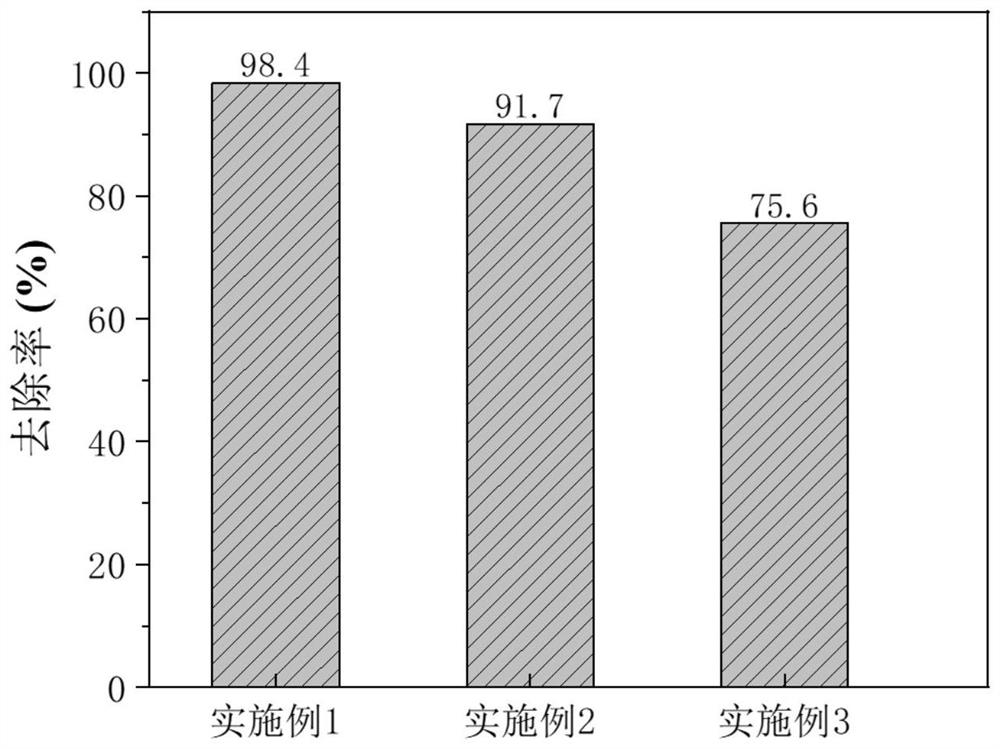Preparation method of hydroxylated magnetic graphene oxide adsorbent
An oxide stone and hydroxylation technology, applied in chemical instruments and methods, adsorption water/sewage treatment, alkali metal oxides/hydroxides, etc., can solve the problems of difficult separation and recovery, limitation of large-scale application, and cost increase, etc. To achieve the effect of excellent adsorption capacity, low cost of raw materials, rapid separation and recovery
- Summary
- Abstract
- Description
- Claims
- Application Information
AI Technical Summary
Problems solved by technology
Method used
Image
Examples
Embodiment 1
[0024] (1) Weigh 1.0 g of graphene oxide, stir it magnetically for 30 minutes, then use a cell pulverizer to ultrasonically disperse it for 30 minutes, and disperse it in an ethylene glycol solvent. Weigh 2 g of sodium dodecylbenzene sulfonate as a surfactant, and stir for 30 min until it is completely dissolved. Subsequently, 1.5 g of ferric chloride pentahydrate was added, and stirred for 2 h to ensure that the iron ions were fully combined with the graphene oxide sheets. Finally, 10.8 g of sodium oxalate was added and stirred for 30 min until a uniform suspension was formed.
[0025] (2) Transfer the suspension prepared in (1) to a hydrothermal reaction kettle, then put the reaction kettle into an oven, set the reaction temperature to 190° C., and the reaction time to 16 hours. After the reaction is over, take it out after cooling to room temperature, use a strong magnet to separate, use deionized water and absolute ethanol as cleaning agents, wash each for 3 times, put it...
Embodiment 2
[0028] (1) Weigh 1.0 g of graphene oxide, stir it magnetically for 30 minutes, then use a cell pulverizer to ultrasonically disperse it for 30 minutes, and disperse it in an ethylene glycol solvent. Weigh 2 g of sodium dodecylbenzene sulfonate as a surfactant, and stir for 30 min until it is completely dissolved. Subsequently, 1.5 g of ferric chloride pentahydrate was added, and stirred for 2 h to ensure that the iron ions were fully combined with the graphene oxide sheets. Finally, 10.8 g of sodium oxalate was added and stirred for 30 min until a uniform suspension was formed.
[0029] (2) Transfer the suspension prepared in (1) to a hydrothermal reaction kettle, then put the reaction kettle into an oven, set the reaction temperature to 190° C., and the reaction time to 16 hours. After the reaction is over, take it out after cooling to room temperature, use a strong magnet to separate, use deionized water and absolute ethanol as cleaning agents, wash each for 3 times, put it...
Embodiment 3
[0032] (1) Weigh 0.5 g of graphene oxide, stir it magnetically for 30 min, and then disperse it in an ethylene glycol solvent using an ultrasonic cell pulverizer for 30 min. Weigh 2 g of sodium dodecylbenzene sulfonate as a surfactant, and stir for 30 min until it is completely dissolved in the dispersion. Subsequently, 1.5 g of ferric chloride pentahydrate was added, and stirred for 2 h to ensure that the iron ions were fully combined with the graphene oxide sheets. Finally, 10.8 g of sodium oxalate was added and stirred for 30 min until a uniform suspension was formed.
[0033] (2) Transfer the suspension prepared in (1) to a hydrothermal reaction kettle, then put the reaction kettle into an oven, set the reaction temperature to 190° C., and the reaction time to 16 hours. After the reaction is over, take it out after cooling to room temperature, use a strong magnet to separate, use deionized water and absolute ethanol as cleaning agents, wash each for 3 times, put it in an ...
PUM
 Login to View More
Login to View More Abstract
Description
Claims
Application Information
 Login to View More
Login to View More - R&D
- Intellectual Property
- Life Sciences
- Materials
- Tech Scout
- Unparalleled Data Quality
- Higher Quality Content
- 60% Fewer Hallucinations
Browse by: Latest US Patents, China's latest patents, Technical Efficacy Thesaurus, Application Domain, Technology Topic, Popular Technical Reports.
© 2025 PatSnap. All rights reserved.Legal|Privacy policy|Modern Slavery Act Transparency Statement|Sitemap|About US| Contact US: help@patsnap.com



